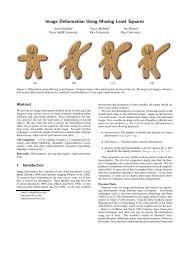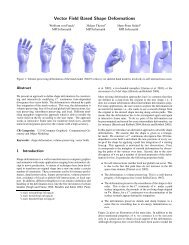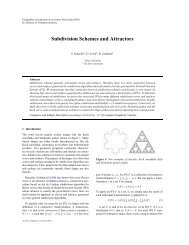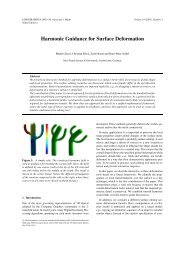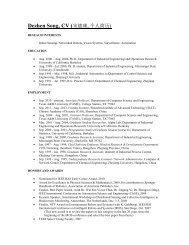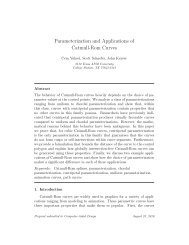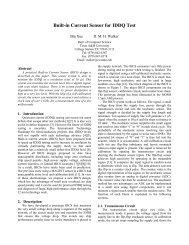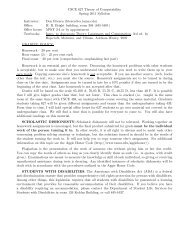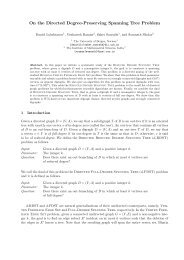TinySec: A Link Layer Security Architecture for Wireless Sensor ...
TinySec: A Link Layer Security Architecture for Wireless Sensor ...
TinySec: A Link Layer Security Architecture for Wireless Sensor ...
You also want an ePaper? Increase the reach of your titles
YUMPU automatically turns print PDFs into web optimized ePapers that Google loves.
<strong>TinySec</strong>: A <strong>Link</strong> <strong>Layer</strong><br />
<strong>Security</strong> <strong>Architecture</strong> <strong>for</strong><br />
<strong>Wireless</strong> <strong>Sensor</strong> Networks<br />
Chris Karlof, Naveen Sastr,<br />
David Wagner<br />
Presented By: Tristan Brown
Outline<br />
• Motivation<br />
• Cryptography Overview<br />
• <strong>TinySec</strong> Design<br />
• Implementation and Evaluation<br />
• Results
Motivation<br />
• Need a secure communications<br />
plat<strong>for</strong>m <strong>for</strong> sensor networks<br />
– Data is broadcast <strong>for</strong> all to hear.<br />
– <strong>Sensor</strong> network nodes have severely<br />
limited resources.<br />
– Can’t use existing architectures designed<br />
<strong>for</strong> powerful devices.
Cryptography Overview<br />
• Why use crypto<br />
• Provide probabilistic guarantees about<br />
messages sent/received on the<br />
network.<br />
– Access control/message integrity<br />
– Confidentiality<br />
– Replay Protection
Access Control/Message<br />
Integrity<br />
• Ensure only authorized senders are<br />
allowed to send messages.<br />
• Ensure messages are unmodified after<br />
transmission.<br />
• Can achieve both with a Message<br />
Authentication Code (MAC).
Message Authentication<br />
Codes<br />
• Essentially a keyed checksum of the<br />
message<br />
• Access Control: Cannot compute MAC<br />
without the key.<br />
• Message Integrity: Any change to the<br />
message invalidates the MAC.
Confidentiality<br />
• Keep message content from<br />
unauthorized viewers.<br />
• Semantic security: ideally should<br />
prevent adversary from learning<br />
anything about the encrypted message.<br />
• Achieved by message encryption with<br />
an Initialization Vector (IV)
Initialization Vector<br />
• Plaintext prefix to the encrypted<br />
message<br />
• Used to add variation to otherwise<br />
identical messages<br />
– Without, identical messages would encrypt<br />
identically, violating semantic security.
Replay Protection<br />
• Prevent a legitimate message from<br />
being resent later.<br />
• Can be achieved by a monotonically<br />
increasing message counter.<br />
• Not addressed by <strong>TinySec</strong>; authors<br />
believe higher layer protocols should<br />
handle this.
<strong>TinySec</strong> Design<br />
• Unsuitability of existing schemes<br />
requires a new design<br />
– High level protocols like SSL or IPSEC are<br />
too heavyweight.<br />
– Existing wireless security designs are still<br />
too limiting<br />
• Insecure (WEP)<br />
• Incomplete (SNEP)
Two-teir design<br />
• Based on the TinyOS Packet<br />
• <strong>TinySec</strong>-Auth replaces the CRC and<br />
group field with a MAC<br />
• <strong>TinySec</strong>-AE adds encryption to<br />
<strong>TinySec</strong>-Auth
Packet Format
MAC<br />
• Protects the entire packet (except the<br />
MAC itself).<br />
• Uses CBC-MAC with packet length<br />
XORed with the first block.<br />
• Store 4 bytes of the result.
MAC<br />
• Is 4 bytes secure<br />
– Requires 2 31 tries on average to brute <strong>for</strong>ce<br />
a single message.<br />
– Given a 20kbps channel would take 20<br />
months; far longer than a node lifetime.<br />
– Numerous MAC failures would give away<br />
the attacker.
MAC<br />
• Remove the CRC and group field to<br />
make room <strong>for</strong> the MAC.<br />
– Groups can be created by using different<br />
keys <strong>for</strong> the CBC.<br />
– MAC provides integrity protection making<br />
the CRC redundant<br />
– Result: MAC increases packet size by only<br />
1 byte.
Encryption<br />
• Two components<br />
– Initialization Vector<br />
– Cipher<br />
• Encrypt only the message<br />
– Allows nodes to per<strong>for</strong>m early rejection<br />
based on AM.
Initialization Vector<br />
• 8 byte IV<br />
– 4 bytes are taken from <strong>TinySec</strong>-Auth<br />
header fields<br />
– 2 bytes are source address<br />
– 2 bytes are a simple counter<br />
• Results in 4 byte packet size increase
Initialization Vector<br />
• How secure is this<br />
– Assuming all other header fields don’t<br />
change, takes 2 16 packets to repeat an IV.<br />
• At 1 packet/minute, will take 45 days to repeat<br />
an IV<br />
– Repeated IV leaks limited in<strong>for</strong>mation (due<br />
to cipher choice).<br />
– If cipher is rekeyed, repeated IV isn’t a<br />
problem.
Cipher<br />
• What kind of cipher should be used<br />
– Stream cipher<br />
• Use key and IV to generate keystream, XOR<br />
with data<br />
• If IV is repeated, can recover XOR of plaintexts.<br />
– Block Cipher (CBC)<br />
• XOR first block with IV, encrypt<br />
• For successive blocks XOR with prior<br />
ciphertext and encrypt.
CBC<br />
• In case of a repeated IV only leaks the<br />
similarity of the first n identical blocks.<br />
• Uses same cipher construct as CBC-<br />
MAC (save on code space)<br />
• Must not use same key <strong>for</strong> encryption<br />
and CBC-MAC!
Keying<br />
• Simple mechanism: use a single pair of keys<br />
<strong>for</strong> all nodes<br />
– Entire network vulnerable to a single-node exploit.<br />
• <strong>Link</strong> keying: use separate keys <strong>for</strong> every pair<br />
of nodes that communicates<br />
– Key distribution is complex<br />
• Group keying: Group nodes together, use<br />
different keys <strong>for</strong> each group.
Implementation and<br />
Evaluation<br />
• Implemented <strong>for</strong> TinyOS on Mica<br />
plat<strong>for</strong>m<br />
• Used skipjack as the block cipher <strong>for</strong><br />
CBC/CBC-MAC<br />
– Unencumbered by patents (unlike rc5)<br />
– High per<strong>for</strong>mance and secure.<br />
• Used single network-wide keypair <strong>for</strong><br />
simplicity.
Per<strong>for</strong>mance<br />
• Small throughput drop/latency rise consistent with the<br />
increased packet size<br />
• No other noticeable difference (all computation can<br />
be completed as the packet is transmitted/received)
Power Consumption
Results<br />
• Mostly effective<br />
authentication/encryption <strong>for</strong> sensor<br />
network environment<br />
– Reduced size IV/MAC offset by inability to<br />
exploit the network without severely<br />
impacting it (node death)<br />
– Some assumptions might not hold in all<br />
environments
Results<br />
• Open Problems<br />
– No keying mechanism (area of active<br />
research)<br />
– <strong>Security</strong> assumptions made based on node<br />
lifetime; keys may outlive nodes.




